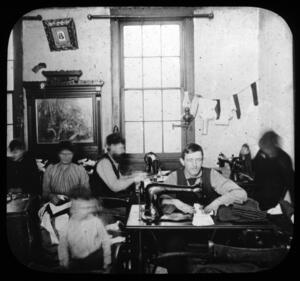Lower East Side Tenements
The overcrowded, poorly lit and ventilated tenements of the Lower East Side were once home to hundreds of thousands of recent Jewish immigrants. In the late 19th century, many of the apartments in these tenements doubled as garment workshops. Clothing manufacturers could have their products sewn and assembled here and avoid the costs of maintaining a factory. In the early 1900s the industry began to move from cramped tenements to large loft buildings like the Triangle's, but few safety measures were introduced.
Many of the young women who worked in the Triangle Factory in 1911 lived in buildings much like the ones on this street. For example, 23-year-old Nettie Lefkowitz, who lived at 27 E. 3rd Street, had emigrated from Romania only 18 months before she was killed in the Triangle fire. A few blocks away, at 14 E. 1st Street, lived another Triangle victim: 17-year-old Celia Eisenberg, who was born in Russia and had been in the U.S. since 1906. Another Russian immigrant, 18-year-old Rosie Freedman, made her home nearby at 77 E. 4th Street.
By the time these young women died in the Triangle fire, the tenements they lived in would no longer have combined garment making and living quarters. Conditions were still grim—just as working conditions were still grim in the new high-rise factories—but things had improved since the days when most garment makers worked in sweatshops located in buildings like these.
In a typical tenement sweatshop, the father sewed at a machine near one of the few windows, while up to half a dozen women worked alongside him in the living room, stitching together pieces of fabric. The workers were paid by how many pieces they finished in a day. In the kitchen, a presser (usually an older man) ironed the completed pieces next to the same stove used for cooking meals.
In this system of making ready-to-wear clothing, the manufacturers cut the garments that were marketed under their names. The rest of the process took place in tenements like this one. There were advantages for the workers. People called each other by their first names, conversed in Yiddish, and sometimes even shared meals prepared by the owner's wife. Memoirs describe singing, dancing, smoking, drinking, and eating. Workers could also have a schedule that allowed them to observe Shabbat.
However, workers could never forget that even in this "family like" setting, the boss had ultimate authority. Unsanitary conditions and the never-ending pressure to work faster and faster made the sweatshop "too narrow for the spirit," as a writer for the Forward newspaper put it. These conditions also made it difficult for inspectors to enforce the few regulations that were on the books and for unions to organize workers.
By 1900, technology was transforming the garment industry. The availability of electric sewing machines made it profitable for manufacturers to move production into the new high-rise loft buildings that were going up all over lower Manhattan. Between 1901, the year the Triangle Waist Company first rented space in the new Asch Building, and 1911, nearly 800 of these buildings were built in Manhattan—an average of three every two weeks! These new factories had higher ceilings than tenements and more windows to let in air and light—and, of course, they had electric power. Slowly but surely, the once ubiquitous tenement sweatshop became obsolete.
One change affected Jewish workers in particular. The new factories operated six (sometimes even seven) days a week, making it impossible to observe the Sabbath. In some observant families, the parents still rested on Saturdays, while their daughters went off to earn the money that paid the rent.





Wow
This is cool